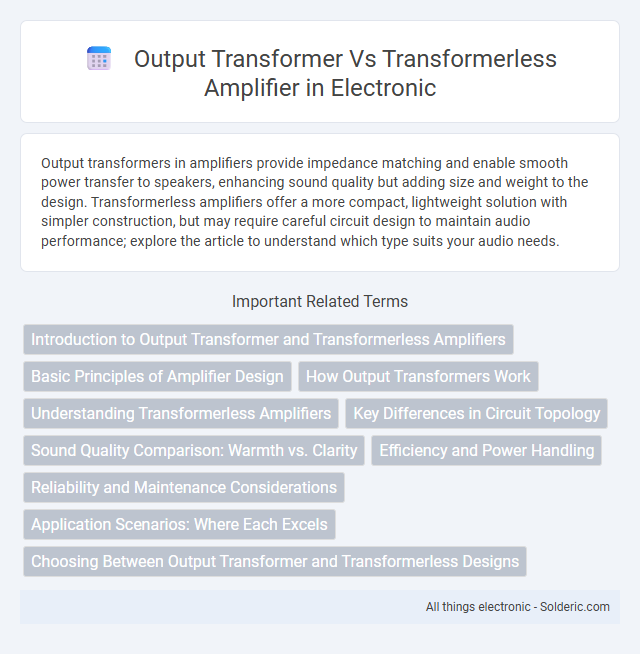Output transformers in amplifiers provide impedance matching and enable smooth power transfer to speakers, enhancing sound quality but adding size and weight to the design. Transformerless amplifiers offer a more compact, lightweight solution with simpler construction, but may require careful circuit design to maintain audio performance; explore the article to understand which type suits your audio needs.
Comparison Table
| Feature | Output Transformer Amplifier | Transformerless Amplifier |
|---|---|---|
| Design | Uses output transformer for impedance matching | Direct coupling, no output transformer |
| Impedance Matching | Provides effective impedance matching between tube and speaker | Relies on circuit design, may have higher output impedance |
| Frequency Response | Limited by transformer bandwidth; potential phase shifts | Wider frequency response, minimal phase distortion |
| Size & Weight | Bulky and heavy due to transformer | Compact and lightweight |
| Cost | Generally higher due to expensive transformer | Lower production cost |
| Durability | Transformer failure can be critical | Fewer components prone to failure |
| Sound Quality | Warm, classic tube sound with transformer coloration | Cleaner sound, less coloration, more transparency |
| Applications | Tube guitar amps, high-end audio | Hi-fi audio, solid-state hybrid designs |
Introduction to Output Transformer and Transformerless Amplifiers
Output transformers in amplifiers serve to match the impedance between the amplifier's output stage and the speaker, ensuring efficient power transfer and minimizing distortion, commonly used in tube amplifiers. Transformerless amplifiers eliminate the output transformer, reducing size, weight, and cost while often improving frequency response and transient performance, primarily seen in solid-state amplifier designs. Each design choice significantly influences the amplifier's sonic characteristics, efficiency, and application suitability.
Basic Principles of Amplifier Design
Output transformer amplifiers utilize magnetic components to match impedance between the amplifier and the speaker, enabling efficient power transfer and tonal coloration prized in vintage and tube amps. Transformerless amplifiers rely on solid-state circuitry to achieve impedance matching, resulting in lighter weight, reduced distortion, and a more transparent sound profile. Understanding these basic principles helps you select the right amplifier design based on desired sound characteristics and application needs.
How Output Transformers Work
Output transformers in amplifiers function by converting the high-voltage, low-current signal from the amplifier's tubes or transistors into a low-voltage, high-current signal suitable for driving speakers, ensuring impedance matching between the amplifier and the speaker to maximize power transfer and minimize distortion. They rely on electromagnetic induction principles, using primary and secondary coils to efficiently transfer audio signals while providing electrical isolation and reducing noise. In contrast, transformerless amplifiers bypass this process, employing alternative circuitry to match impedance and drive speakers directly without the bulk and tonal coloration introduced by output transformers.
Understanding Transformerless Amplifiers
Transformerless amplifiers offer improved frequency response and reduced size by eliminating bulky output transformers, making them ideal for high-fidelity audio applications. These amplifiers utilize direct coupling or capacitive coupling techniques to maintain signal integrity, enhancing linearity and reducing distortion. Their design allows better efficiency and extended bandwidth compared to traditional output transformer amplifiers, benefiting both professional and consumer audio equipment.
Key Differences in Circuit Topology
Output transformer amplifiers use a magnetic core device to match impedance between the output tube and speaker, providing voltage gain and isolation, while transformerless amplifiers eliminate this component to achieve lower weight and size with a direct coupling approach. Transformer amplifiers tend to have more complex winding arrangements, including primary and secondary coils, whereas transformerless designs rely on transistor or MOSFET stages with resistor networks for impedance matching and signal conditioning. Your choice between these topologies affects audio characteristics, circuit complexity, and overall amplifier efficiency.
Sound Quality Comparison: Warmth vs. Clarity
Output transformer amplifiers deliver a warm, rich sound characterized by smooth midrange tones and pleasing harmonic distortion, often favored by audiophiles and musicians seeking vintage tonal qualities. Transformerless amplifiers provide superior clarity and transparency, offering a more accurate and detailed reproduction of audio with less coloration and faster transient response. Your choice between warmth and clarity depends on whether you prioritize the nostalgic, musical warmth of transformer-coupled circuits or the precise, clean sound of transformerless designs.
Efficiency and Power Handling
Output transformer amplifiers typically offer lower efficiency due to energy losses in the transformer but excel at handling high power outputs with enhanced impedance matching. Transformerless amplifiers achieve higher efficiency by eliminating transformer losses, enabling more direct power delivery and better thermal management. Your choice depends on whether efficiency or power handling is the priority in your audio amplification setup.
Reliability and Maintenance Considerations
Output transformer amplifiers typically require more maintenance due to the physical wear and potential failure of the transformer, which can lead to signal degradation over time. Transformerless amplifiers offer enhanced reliability with fewer components prone to malfunction, reducing overall maintenance needs. Your choice should consider the operational environment and long-term serviceability to ensure consistent performance.
Application Scenarios: Where Each Excels
Output transformers excel in high-fidelity audio equipment and guitar amplifiers, providing impedance matching and harmonic enrichment critical for tube amplifiers. Transformerless amplifiers are favored in low-noise, high-frequency applications such as headphone amplifiers and stage monitors due to their reduced weight, cost, and extended frequency response. The choice depends on the need for tonal coloration and impedance matching versus efficiency and clarity across a broader frequency range.
Choosing Between Output Transformer and Transformerless Designs
Choosing between output transformer and transformerless amplifier designs depends on your audio goals and system compatibility. Output transformer amplifiers offer classic tonal warmth and impedance matching beneficial for tube setups, while transformerless amplifiers provide higher efficiency, lower distortion, and extended frequency response ideal for modern, solid-state systems. Your choice should balance the desired sound character with practical considerations like weight, size, and maintenance requirements.
Output transformer vs Transformerless amplifier Infographic

 solderic.com
solderic.com